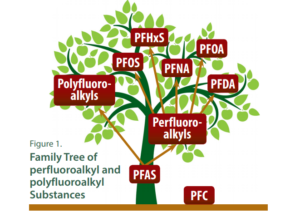Fort Ord, Closed for Years, High Levels of Toxic Chemicals Remain for Local Residents
Military Poisons | 27 April 2020
Although the base closed 26 years ago, the presence of the “forever chemicals” at these levels provides a wake-up call to the public in the region that PFAS is present at harmful levels in the ground. Customers of California Water Service – Salinas should be especially cognizant of the potential for contamination. Groundwater from the base is reported to move in a northeasterly direction toward Salinas while the town’s water supply is derived largely from groundwater.
No federal or state maximum contaminant levels for PFAS chemicals in drinking water have been established. In February, 2020, however, the California State Water Resources Control Board lowered its “Response Level” to 10 parts per trillion (ppt) for PFOA and 40 ppt for PFOS. If a water system exceeds the response levels for these contaminants, the system is required to take the water source out of service or provide public notification within 30 days of the confirmed detection. Previously, the response level was 70 ppt for the total concentration of the two contaminants combined. The groundwater at Fort Ord contained 113 ppt of PFOA and 447 ppt of PFOS.
Because of the new regulations water systems throughout the state have been required to either shut down drinking water wells or treat the water so it is deemed safe to drink.

People in the Seaside-Salinas area who drink from private wells should be careful not to drink water containing PFAS. Neither the federal government not the state regulate well water.
A recent news story in the Monterey County Weekly omits the alarming analytical results while quoting a spokesperson for the Army saying there is little risk to public health from PFAS contamination at the base. It is not surprising that the Army or its contractors would be downplaying the threat to public health posed by the Army’s use of toxic firefighting foams during firefighting drills and in overhead foam suppression systems for over twenty years at Fort Ord.
“Fortunately, compared to other [Department of Defense] sites, the presence of PFAS is not that extensive,” says William Collins, environmental coordinator of the military’s local Base Realignment and Closure office. “The chemicals were not frequently used here and not in large quantities.”
Collins said, “Where we found PFAS, it is being removed.”Perhaps Collins is referring to just PFOS and PFOA – two types of PFAS (per- and poly fluoroalkyl substances.) This, in itself, is a pretty tall order considering the amount of the AFFF used over the years and the distances the chemicals have likely traveled in underground plumes. The Ahtna report only provided the results of contamination for two PFAS chemicals while the Army, like the other branches of the military, is likely to have used dozens of the toxins in a variety of applications.We were provided a glimpse of the contaminants poisoning the groundwater by the military when the Lahontan Regional Water Board tested the well water of a home in Victorville, California two years ago. The water was found to contain high levels of 25 separate PFAS chemicals. The home is located close to the shuttered George AFB which closed 28 years ago.
The public in Salinas and Seaside won’t learn about the exact levels of these chemicals in their groundwater or drinking water unless they are proactive. Certainly, they cannot rely on the Army to be candid. Public health professionals say people should not ingest more than 1 ppt of PFAS daily.
The Monterey County Weekly reported that the Army identified sites where more investigation is needed. The most obvious place to look more thoroughly is Site 10, the Burn Pit – Fire Training Area. Aqueous film-forming foam (AFFF) was used there for at least two decades. Typically, Army fire pits consisted of a roughly 100-foot diameter unlined crater. Typical fire training activity included dispersing drummed waste oils, solvents, contaminated oils and jet fuels until the ground was saturated and the substances formed a pool. Then firefighters would ignite the fuel and extinguish the fire using deadly AFFF.
It is not good for the environment.
The Foam suppression system in Building 507 is shown in this photo.
To gain an idea of how these systems contaminate the environment, see this madness…”
Compiled by Stephen I. Schwartz, 2002
https://www.brookings.edu/bombs-in-the-backyard/
https://www.ewg.org/tapwater/system.php?pws=CA2710017
Data available: 2012—2017 Source: Groundwater Contaminants Detected 8
EXCEED EWG HEALTH GUIDELINES16 Total Contaminants
EWG’s drinking water quality report shows results of tests conducted by the water utility and provided to the Environmental Working Group by the California State Water Resources Control Board, as well as information from the U.S. EPA Enforcement and Compliance History database (ECHO). For the latest quarter assessed by the U.S. EPA (January 2019 – March 2019), tap water provided by this water utility was in compliance with federal health-based drinking water standards.
Legal does not necessarily equal safe. Getting a passing grade from the federal government does not mean the water meets the latest health guidelines.
https://www.denix.osd.mil/derp/home/documents/installation-restoration-program-report-to-congress-january-2018/
Key: DERA – Defense Environmental Restoration Account funds
BRAC – Base Realignment and ClosureArmy California FORT ORD BRAC FTO-012 AREA/CANNIBAL.YD 202409 2,629 8
Army California FORT ORD BRAC FTO-039 SITE 39 INLAND RANGES 202609 6,063 10
Army California FORT ORD BRAC FTO-044 RESERVATION ROAD SITE 202609 6,961 10
Army California FORT ORD BRAC FTO-053 LANDFILL (OU2) 203109 38,525 15

